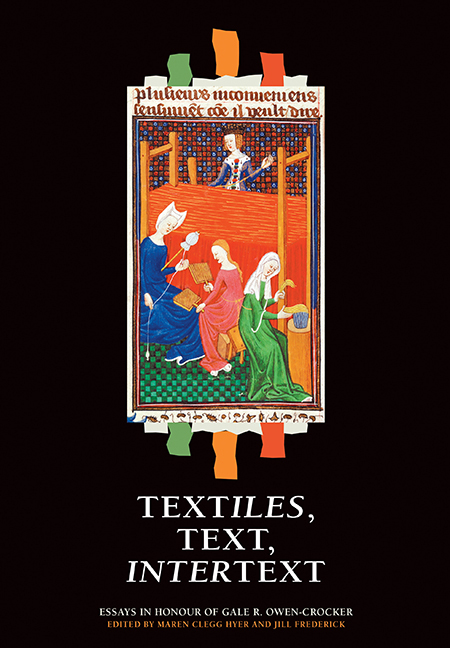38 results
4 - Survival, Recovery, Restoration, Re-creation: The Long Life of Medieval Garments
-
-
- Book:
- Refashioning Medieval and Early Modern Dress
- Published by:
- Boydell & Brewer
- Published online:
- 12 June 2021
- Print publication:
- 15 November 2019, pp 59-74
-
- Chapter
- Export citation
Part III - Intertext
-
- Book:
- Textiles, Text, Intertext
- Published by:
- Boydell & Brewer
- Published online:
- 05 July 2016
- Print publication:
- 18 March 2016, pp 181-182
-
- Chapter
- Export citation
Frontmatter
-
- Book:
- Textiles, Text, Intertext
- Published by:
- Boydell & Brewer
- Published online:
- 05 July 2016
- Print publication:
- 18 March 2016, pp i-iv
-
- Chapter
- Export citation
Index
-
- Book:
- Textiles, Text, Intertext
- Published by:
- Boydell & Brewer
- Published online:
- 05 July 2016
- Print publication:
- 18 March 2016, pp 255-264
-
- Chapter
- Export citation
List of Abbreviations
-
- Book:
- Textiles, Text, Intertext
- Published by:
- Boydell & Brewer
- Published online:
- 05 July 2016
- Print publication:
- 18 March 2016, pp viii-viii
-
- Chapter
- Export citation
2 - Opus What? The Textual History of Medieval Embroidery Terms and Their Relationship to the Surviving Embroideries c. 800–1400
- from Part I - Textile
-
-
- Book:
- Textiles, Text, Intertext
- Published by:
- Boydell & Brewer
- Published online:
- 05 July 2016
- Print publication:
- 18 March 2016, pp 43-68
-
- Chapter
- Export citation
List of publications of Gale R. Owen Crocker
-
- Book:
- Textiles, Text, Intertext
- Published by:
- Boydell & Brewer
- Published online:
- 05 July 2016
- Print publication:
- 18 March 2016, pp 17-24
-
- Chapter
- Export citation
Part I - Textile
-
- Book:
- Textiles, Text, Intertext
- Published by:
- Boydell & Brewer
- Published online:
- 05 July 2016
- Print publication:
- 18 March 2016, pp 25-26
-
- Chapter
- Export citation
Tabula Gratulatoria
-
- Book:
- Textiles, Text, Intertext
- Published by:
- Boydell & Brewer
- Published online:
- 05 July 2016
- Print publication:
- 18 March 2016, pp 265-265
-
- Chapter
- Export citation

Textiles, Text, Intertext
- Essays in Honour of Gale R. Owen-Crocker
-
- Published by:
- Boydell & Brewer
- Published online:
- 05 July 2016
- Print publication:
- 18 March 2016
Contents
-
- Book:
- Textiles, Text, Intertext
- Published by:
- Boydell & Brewer
- Published online:
- 05 July 2016
- Print publication:
- 18 March 2016, pp v-vi
-
- Chapter
- Export citation
List of Illustrations
-
- Book:
- Textiles, Text, Intertext
- Published by:
- Boydell & Brewer
- Published online:
- 05 July 2016
- Print publication:
- 18 March 2016, pp vii-vii
-
- Chapter
- Export citation
Part II - Text
-
- Book:
- Textiles, Text, Intertext
- Published by:
- Boydell & Brewer
- Published online:
- 05 July 2016
- Print publication:
- 18 March 2016, pp 119-120
-
- Chapter
- Export citation
6 - Landmarks of Faith: Crosses and other Free-standing Stones
-
-
- Book:
- The Material Culture of the Built Environment in the Anglo-Saxon World
- Published by:
- Liverpool University Press
- Published online:
- 17 June 2017
- Print publication:
- 31 December 2015, pp 117-136
-
- Chapter
- Export citation
8 - “A formidable undertaking”: Mrs. A. G. I. Christie and English Medieval Embroidery
-
-
- Book:
- Medieval Clothing and Textiles 10
- Published by:
- Boydell & Brewer
- Published online:
- 14 February 2023
- Print publication:
- 17 April 2014, pp 165-194
-
- Chapter
- Export citation
4 - Decorative Techniques 1: Changes of Surface or Form
-
- Book:
- The Art of the Anglo-Saxon Goldsmith
- Published by:
- Boydell & Brewer
- Published online:
- 17 March 2023
- Print publication:
- 01 June 2002, pp 102-131
-
- Chapter
- Export citation
9 - The Anglo-Saxon Goldsmith in His Society
-
- Book:
- The Art of the Anglo-Saxon Goldsmith
- Published by:
- Boydell & Brewer
- Published online:
- 17 March 2023
- Print publication:
- 01 June 2002, pp 227-246
-
- Chapter
- Export citation
Acknowledgements
-
- Book:
- The Art of the Anglo-Saxon Goldsmith
- Published by:
- Boydell & Brewer
- Published online:
- 17 March 2023
- Print publication:
- 01 June 2002, pp xii-xii
-
- Chapter
- Export citation
Frontmatter
-
- Book:
- The Art of the Anglo-Saxon Goldsmith
- Published by:
- Boydell & Brewer
- Published online:
- 17 March 2023
- Print publication:
- 01 June 2002, pp i-iv
-
- Chapter
- Export citation
1 - Introduction: the Background to the Study of the Anglo-Saxon Goldsmith
-
- Book:
- The Art of the Anglo-Saxon Goldsmith
- Published by:
- Boydell & Brewer
- Published online:
- 17 March 2023
- Print publication:
- 01 June 2002, pp 1-18
-
- Chapter
- Export citation



